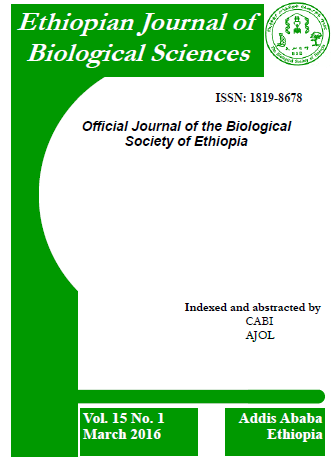PERFORMANCE EVALUATION OF SOME CHILI PEPPER (CAPSICUM SPP) GENOTYPES FOR ANTHRACNOSE (COLLETOTRICHUM CAPSICI (SYD)) RESISTANCE IN SNNP REGION OF ETHIOPIA
Abstract
Ten chili (Capsicum spp) varieties were screened for resistance to anthracnose (Colletotrichum capsici) in field experiments at two locations, Alaba and Maraqo. Starting seven days after transplanting, plants in each plot were monitored for diseases symptoms and infections. Data on incidence and severity of anthracnose were collected. Besides, the disease progress curve (AUDPC) and yield components were recorded before and after harvest. The data showed that the incidence of anthracnose disease and yield parameters such as dry fruit weight per plant, number of fruit per plant, pulp weight per plant, unmarketable fruits weight per plant, fruit length and days to 50 percent maturity, differed significantly among the tested genotypes at both locations. The majority of the genotypes were rated as moderate resistant to susceptible ones and none of the genotypes was free from the disease at both locations. Total yield per plant was higher at Alaba than Maraqo. This variation is related to the level of disease intensity, which was higher at Maraqo. After thorough multi-location researches, the identified sources of resistance were recommended to be utilized in future pepper breeding programs.
Downloads
References
AVRDC (Asian Vegetable Research and Development Centre) (2003). AVRDC Progress Report for 2002. Asian Vegetable Research and Development Centre, Taiwan, China.
Badu-Apraku, B., Fakorede, M.A.B., Menkir, A. and Sanogo, D. (eds.) (2012). Conduct and management of maize field trials. IITA, Ibadan, Nigeria.
Basavaraj, N. (1997). Genetic Variability and Genetics of Quantitative and Quality Characters in Green Chili (Capsicum annuum L.) Genotypes. PhD. Thesis, University of Agricultural Sciences, Dharwad, India.
Belete, N., Alemayehu, C., Girma, T.G., and Teferi, G.E. (2012). Evaluation of farmers’ “Markofana–types” pepper genotypes for powdery mildew (Leveillula taurica) resistance in Southern Ethiopia. Int. J. Basic Appl. Sci. 1(2).
Chakravorty, R., Neog, K., Das, R. and Datta, R.K. (2003). Seasonal incidence of major foliar fungal diseases of mulberry in North East India. Indian J. Sericulture 42(2): 122–127.
CSA (Central Statistical Authority of Ethiopia) (2006). Agricultural sample survey. Report on area and production of crops. Statistical bulletin, 1:361. Addis Ababa, Ethiopia.
CSA (Central Statistical Authority of Ethiopia) (2013). Agricultural sample survey. Report on area and production of crops. Statistical bulletin, 1:532.
Dikshit, B.K., Dash, B.D. and Purohit, K.M. (2006). Studies on the incidence of mulberry foliar diseases in agro-climatic conditions of Koraput district in Orissa. Proceeding, RSRS, CSB, Dehradun. pp. 109-111.
More inside the PDF
